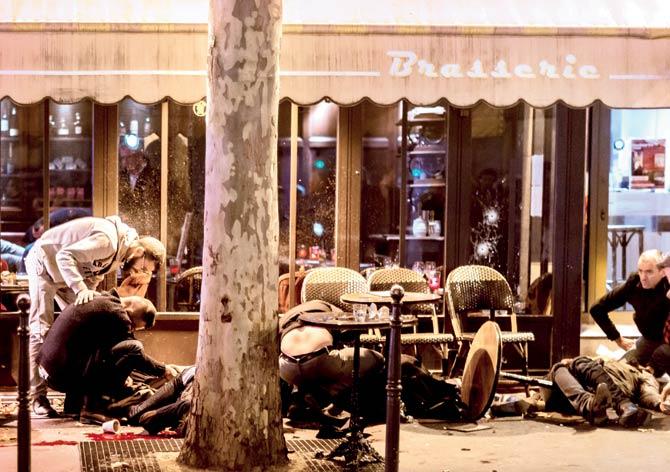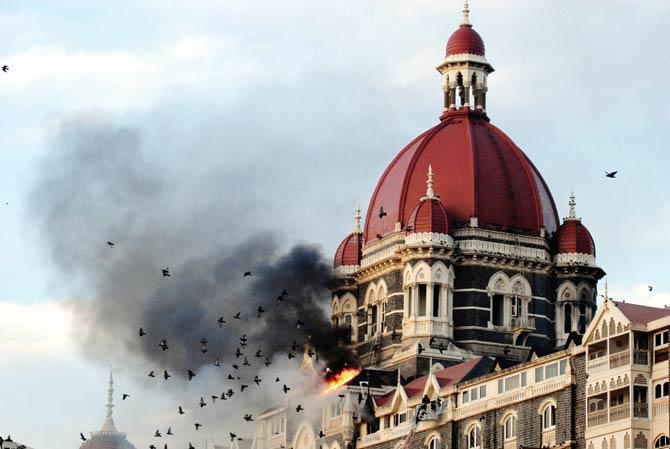With uncanny similarities between weapons used and modus operandi of Mumbai and Paris terror attacks, experts admit inadequate ground intelligence gathering in India could be a disaster in-waiting

As the world watched a terror attack unfold in Paris on Friday night, an eerie sense of deja vu struck Mumbai. The eight terrorists of the Islamic State, armed with automatics and wearing suicide vests — who killed 127 people, injuring over 200 — reminded Mumbai of the 10 men who had seven years ago, launched a similar attack here. In fact, many reports suggested that even the choice of weapons and modus operandi were similar to those used in the 26/11 attacks.
Also read: Paris terror attacks - 'The right-wing is against Muslims'
ADVERTISEMENT

People on the pavement at the tarrasse of Cafe Bonne Biere in Paris, on November 13, 2015, following attacks in and around the city which left more than 120 people dead. AFP photo/Anthony Dorfmann
Such was the similarity between the two attacks that it forced Maharashtra chief minister Devendra Fadnavis to direct the Director General of Police to put his force on high alert in the state. However, while the state may have the capability to counter such strikes, what it requires is the human intelligence network that will help it nip them in the bud.

On November 26, 2008, 10 Lashkar-e-Taiba terrorists attacked six sites in Mumbai, including the iconic Taj Mahal Palace & Towers. Over 160 people were killed in the attacks and 308 were injured
Hunting for sleepers
Intelligence and Senior IPS officers, who have worked to keep the city safe on many occasions, believe that even today, sleeper cells are active in and around Mumbai. The police, however, do not have the capability to sniff them out.
Also read: Post Paris attacks, Mumbai security tightened

Baggage being checked at the Chhatrapati Shivaji Terminus on Saturday, in the wake of the alert announced in the city following Saturday’s Paris attacks. Pic/Atul Kamble
KP Raghuvanshi, former State Anti Terrorism Squad chief, Director General of Police (retired), who probed the 7/11 serial train blasts, admits that much remains by way of building an intelligence gathering network.
However, he cautioned against seeing too many similarities between the Paris and Mumbai strikes. “There is a difference between the two. The Paris terror attack was the work of sleeper modules and it included suicide bombers, whereas 26/11 had no suicide bombers,” he said, adding that while French security agencies were apprehensive and had intelligence of such an attack post the Syria unrest, this was not the case with the 26/11 attack.
Also read: Paris attacks sees 127 dead, one terrorist identified as French national
He added, “Also, it is important to understand that attacks in Mumbai prior to 26/11 were all conducted by sleeper modules in and around the city — for instance, the 2011 Opera House and Dadar (West) blasts which killed 26 and injured 130 people; 2006 serial train blasts that killed 209 people and injured over 700. These modules had played an active role in planting or providing logistical support to the terrorists. And it is a fact that such sleeper modules may be existing even today.”
He added that while the state has its own counter-attack force in the form of Force One and the National Security Guard, “The need of the hour is to penetrate deep within the population to gather human intelligence with the help of technology and then bring both together for analysing and decoding the plan, before any strike.”
“If they [state agencies] are vigilant in their networking, they will be able to ward off attacks, as terrorists need sleeper modules for logistical support,” said Former Union Home Secretary GK Pillai, adding that central agencies would find the job difficult, given the size and population of the country.
Changing tech, society
Colonel (retired) Mahendra Pratap Choudhary (75), who raised and commanded the first anti-terrorist black cat commando force (now known as NSG) in 1982, said the Mumbai police also needs a separate team dedicated to gathering intelligence, especially to keep an eye on radicalized people, who can be trained and used as terror modules and activate them as and when needed.
“Apart from intelligence, we have no access to advanced technology to track communications made through Skype or to decode non-traceable encrypted calls. Had our ground intelligence networking been efficient, the security agencies would have had prior information about the four Kalyan boys who had joined ISIS,” he said.
Also read: No Indian casualty in Paris terror attacks so far, says embassy
Agreeing to the concerns raised by Col Choudhary, a senior intelligence officer admitted that grassroots penetration of intelligence network was a major challenge in a city where people don’t care to know much about their neighbours.
“Earlier people would know their neighbours or people in their locality by name and face. Today, it’s different. Rampant urbanization in and around Mumbai, especially in places like Thane, Mumbra, Nallasopara, Bhiwandi, Padgha and Navi Mumbai has witnessed a large number of migrating population, which can easily become a hideout for sleeper cells,” he added.
It didn’t help, he said, that the police agree to bribes of a few hundred rupees to sign off on a verification form for those signing on new leave and license agreements — a security measure to ensure that every resident of an area is verified.
Force One won’t help
While Raghuvanshi believed that having its own forces — Force One and NSG — would help the city counter another 26/11, Col Choudhary said it’s best not to get our hopes up too high.
He added, “These units need to be at the site of attack within three to five minutes, and be able to eliminate the terrorist immediately. Remember, the terrorists themselves will be keen to take control of the location or target, and cause severe damage to innocent lives and property. The force cannot be mobilized by road since they are paralyzed with traffic. They need to be airlifted followed by proper landing arrangements.”
Also read: Paris attack similar to 26/11 Mumbai assault, feel experts
However, Additional Director General of Police (Housing) Himanshu Roy, who was earlier heading the Anti Terrorism Squad (ATS), said, “The 26/11 terror strikes were a learning lesson, not only to Mumbai and Indian security agencies but for the entire world. While we need to upgrade our intelligence gathering system technically, it is an issue that is being addressed. Moreover, post the incident of the Kalyan youth joining ISIS, we have discretely started a de-radicalisation programme for youth, which has got overwhelming support.”
When SUNDAY mid-day spoke to State Director General of Police Praveen Dixit, all he would say was, “We do not have any specific intelligence at this moment. However, we have asked all concerned security agencies to be on alert, including the state intelligence department, in order to ensure that no untoward incidents happen.”
 Subscribe today by clicking the link and stay updated with the latest news!" Click here!
Subscribe today by clicking the link and stay updated with the latest news!" Click here!







